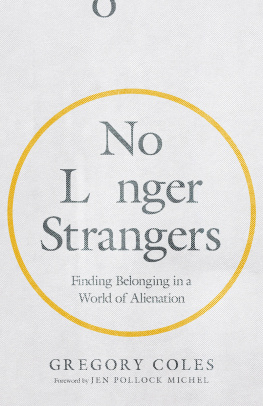Gregory Coles - Cliffsnotes on Lahiris the Namesake
Here you can read online Gregory Coles - Cliffsnotes on Lahiris the Namesake full text of the book (entire story) in english for free. Download pdf and epub, get meaning, cover and reviews about this ebook. year: 2017, publisher: HMH Books, genre: Detective and thriller. Description of the work, (preface) as well as reviews are available. Best literature library LitArk.com created for fans of good reading and offers a wide selection of genres:
Romance novel
Science fiction
Adventure
Detective
Science
History
Home and family
Prose
Art
Politics
Computer
Non-fiction
Religion
Business
Children
Humor
Choose a favorite category and find really read worthwhile books. Enjoy immersion in the world of imagination, feel the emotions of the characters or learn something new for yourself, make an fascinating discovery.
- Book:Cliffsnotes on Lahiris the Namesake
- Author:
- Publisher:HMH Books
- Genre:
- Year:2017
- Rating:4 / 5
- Favourites:Add to favourites
- Your mark:
- 80
- 1
- 2
- 3
- 4
- 5
Cliffsnotes on Lahiris the Namesake: summary, description and annotation
We offer to read an annotation, description, summary or preface (depends on what the author of the book "Cliffsnotes on Lahiris the Namesake" wrote himself). If you haven't found the necessary information about the book — write in the comments, we will try to find it.
CliffsNotes on Jhumpa Lahiris The Namesake includes summaries and analyses of this best-selling novel about a familys struggles to assilmilate into American culture.
Cliffsnotes on Lahiris the Namesake — read online for free the complete book (whole text) full work
Below is the text of the book, divided by pages. System saving the place of the last page read, allows you to conveniently read the book "Cliffsnotes on Lahiris the Namesake" online for free, without having to search again every time where you left off. Put a bookmark, and you can go to the page where you finished reading at any time.
Font size:
Interval:
Bookmark:
Copyright 2017 Houghton Mifflin Harcourt Publishing Company
All rights reserved
www.hmhco.com
cliffsnotes.com
No part of this work may be reproduced or transmitted in any form or by any means, electronic or mechanical, including photocopying and recording, or by any information storage or retrieval system without the prior written permission of Houghton Mifflin Harcourt Publishing Company unless such copying is expressly permitted by federal copyright law. For information about permission to reproduce selections from this book, write to trade.permissions@hmhco.com or to Permissions, Houghton Mifflin Harcourt Publishing Company, 3 Park Avenue, 19th Floor, New York, New York 10016.
The publisher and the author make no representations or warranties with respect to the accuracy or completeness of the contents of this work and specifically disclaim all warranties, including without limitation warranties of fitness for a particular purpose. No warranty may be created or extended by sales or promotional materials. The advice and strategies contained herein may not be suitable for every situation. This work is sold with the understanding that the publisher is not engaged in rendering legal, accounting, or other professional services. If professional assistance is required, the services of a competent professional person should be sought. Neither the publisher nor the author shall be liable for damages arising here from. The fact that an organization or Website is referred to in this work as a citation and/or a potential source of further information does not mean that the author or the publisher endorses the information the organization or Website may provide or recommendations it may make. Further, readers should be aware that Internet Websites listed in this work may have changed or disappeared between when this work was written and when it is read.
Trademarks: CliffsNotes, the CliffsNotes logo, Cliffs, cliffsnotes.com, and all related trademarks, logos, and trade dress are trademarks or registered trademarks of Houghton Mifflin Harcourt Publishing Company. All other trademarks are the property of their respective owners. Houghton is not associated with any product or vendor mentioned in this book.
Library of Congress Cataloging-in-Publication data is available.
eISBN 978-1-328-78027-0
v1.0417
Jhumpa Lahiris The Namesake tells the story of the Gangulis, a Bengali American family grappling with love, loss, and identity in the final thirty years of the 20th Century.
When Ashoke Ganguli survives a catastrophic train accident in India thanks to a book of short stories written by Nikolai Gogol, he decides to move to America. Shortly after the move, he enters an arranged marriage with Ashima, and they give birth to a son. A twist of fate keeps them from naming the boy according to Bengali traditions, so they give him the name Gogol instead. As he grows, Gogol comes to hate his name and decides to change it, hoping to leave both his former name and his Bengali heritage behind. Now as Nikhil, he begins dating a woman named Maxine, living with her family and adopting their culture while ignoring his own. However, Gogol is pulled back to his Bengali heritage after his father dies of a heart attack. Gogol then marries a fellow Bengali American named Moushumi. Their marriage lasts only a few years before Moushumi, also rebelling against her Bengali heritage, has an affair with a white man. This final loss forces Gogol to come to grips not only with his multiple names but also with his multiple identities.
Written by: Jhumpa Lahiri
Type of Work: Fiction
Genre: Contemporary Fiction
First Published: 2004
Setting (primary): Boston, Massachusetts
Settings (secondary): New York City; Calcutta, India; New Haven, Connecticut
Main Characters: Ashima (Bhaduri) Ganguli; Ashoke Ganguli; Gogol/Nikhil Ganguli; Sonali Sonia Ganguli; Moushumi Mazoomdar; Maxine Ratliff
Major Thematic Topics: cultural identity; the power of names and naming; the immigrant experience; love and commitment; memory
Major Symbols: trains; Christmas traditions; Indian foods made with American ingredients; The Short Stories of Nikolai Gogol
Movie Version:The Namesake (2006)
The three most important aspects of The Namesake: The first important aspect of The Namesake is its exploration of Bengali American identity. Each Ganguli family member struggles to understand how to reconcile life in America with Bengali culture and heritage. This struggle is most obvious in Gogol, who tries to escape his Bengali heritage while in college and later, especially by dating women who seem American to him. In his relationship with Maxine, he functionally exchanges his own Bengali family for Maxines stereotypically white American family. He tries to bury his memories of the past, believing that his Bengali heritage keeps him from being the kind of American he wishes to be. Only Ashokes death is powerful enough to pull Gogol back to his Bengali roots, forcing him to negotiate an identity that is both American and Bengali rather than seeing the two cultures as irreconcilable. Ashima struggles in the opposite way: Her dedication to her past in India makes her resistant to becoming too American. For her, Ashokes death becomes a reminder of all the precious memories they have shared in America, and she, too, begins to think of herself simultaneously Bengali and American. Her resolution to spend six months of each year in Calcutta and six months in America symbolizes the joint identity at which she finally arrives.
The second important aspect of The Namesake is much like the first: the relationship between names and identities. As the novels title implies, the matter of Gogols name and his namesake is central to the story. The name Gogol complicates Gogols childhood identity because it is neither American nor Bengali. Gogols rejecting his childhood name in favor of the name Nikhil coincides with his attempt to flee everything about his childhood as well. When he calls himself Nikhil, Gogol feels like a different person, and he prefers being this other person. Still, the rich history of the name Gogol is also part of the heritage Gogol receives from his fatherand in the end of the novel, Gogols choice to be at peace with his own past is also a choice to begin reading about the original Gogol who changed his fathers life.
A third key aspect of The Namesake is its examination of love and obligation. Ashoke and Ashima have a relationship that begins with obligation and has no love at first. But by the time of Ashokes death, Ashima knows that she has loved Ashoke deeply. Their journey of romance is far different from their childrens journeys. Gogols relationship with Maxine seems based on love without obligation; Gogol enjoys being in a relationship that violates the Bengali patterns of obligation his parents followed. But this lack of obligation also leads to a lack of depth: Gogol realizes that he has never truly allowed Maxine to know him deeply. Moushumis marriage with Gogol seems to be a combination of both attraction and obligation; over time, however, as the relationship begins to remind her more and more of her parents obligation-based Bengali marriage, she falls out of love with Gogol. The novel offers no easy answers about romance, only a discussion of the possible outcomes of each approach.
The Namesake covers five primary periods in the life of the Ganguli family:
Chapters 1 and 2 narrate the story of the Gangulis early days in America. Ashoke decided to move to Boston and begin graduate school after barely surviving a catastrophic train accident in India. A few years later, his parents and Ashimas parents arranged their marriage, and Ashima left Calcutta to join Ashoke in Boston. As the novel begins, the two of them are going to a Boston hospital because Ashima is in labor with their first child.
Next pageFont size:
Interval:
Bookmark:
Similar books «Cliffsnotes on Lahiris the Namesake»
Look at similar books to Cliffsnotes on Lahiris the Namesake. We have selected literature similar in name and meaning in the hope of providing readers with more options to find new, interesting, not yet read works.
Discussion, reviews of the book Cliffsnotes on Lahiris the Namesake and just readers' own opinions. Leave your comments, write what you think about the work, its meaning or the main characters. Specify what exactly you liked and what you didn't like, and why you think so.















